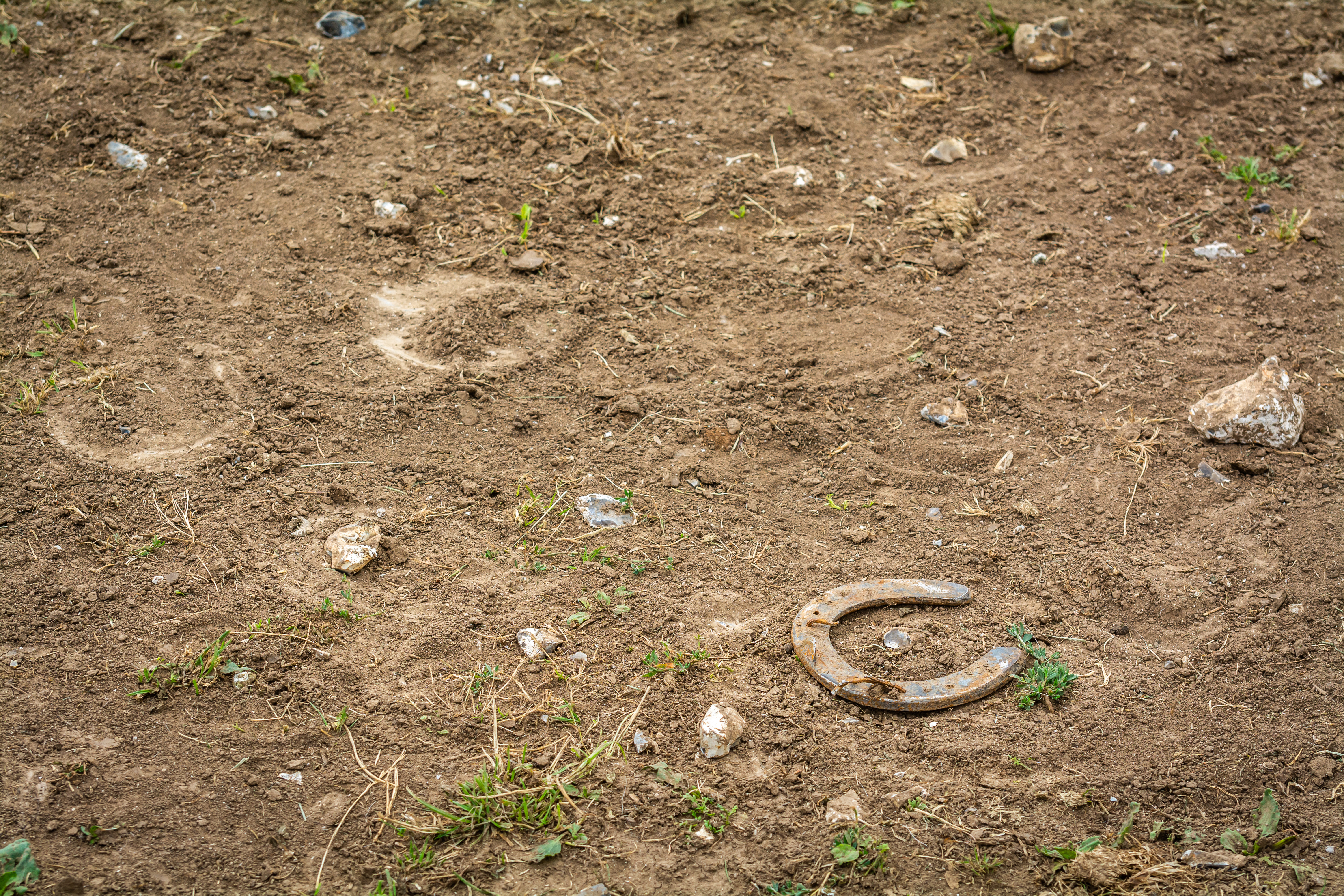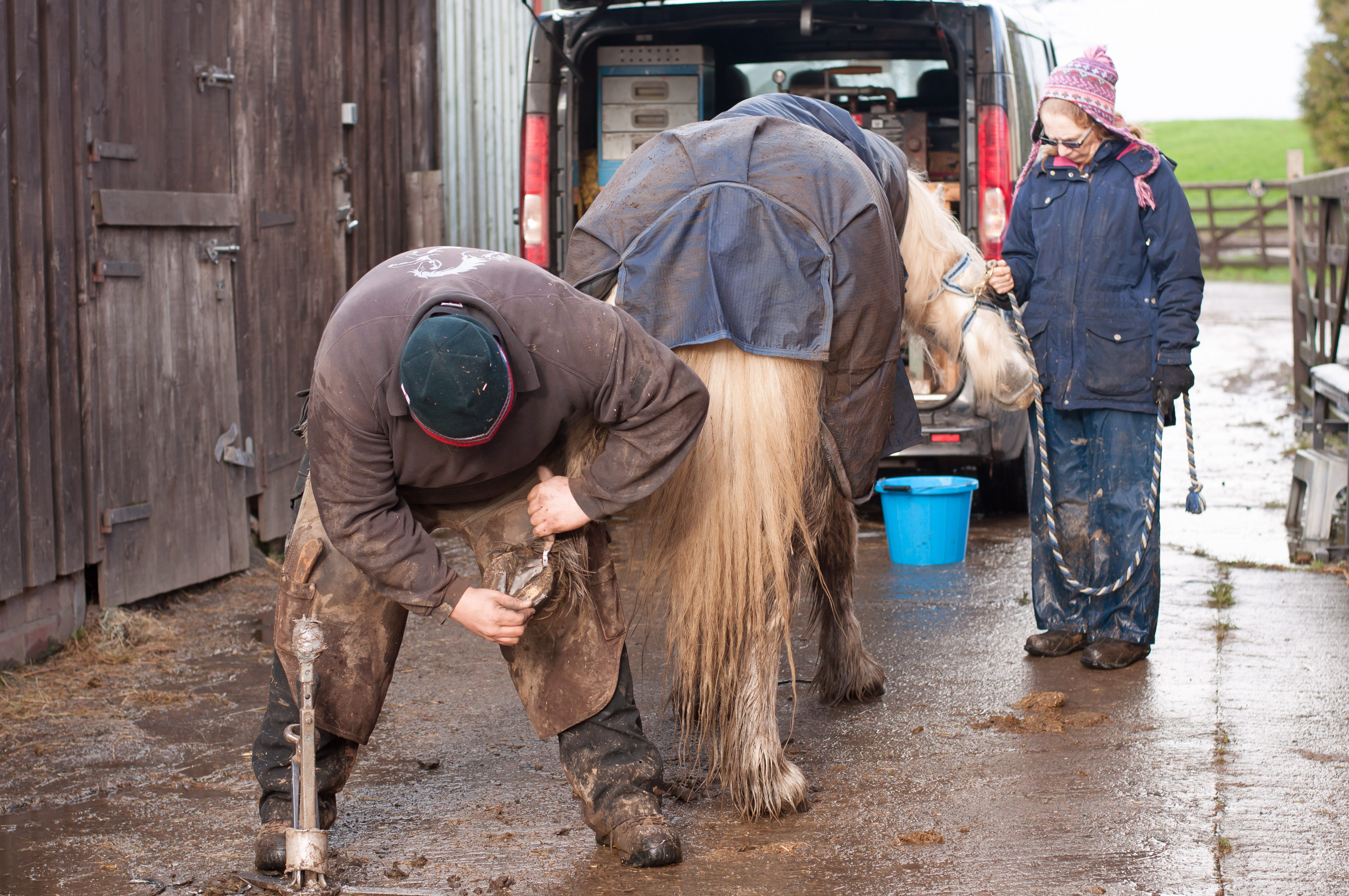Home > Horse Care > How to keep your horse from losing his shoes
How to keep your horse from losing his shoes
- April 8, 2025
- ⎯ Joanne Meszoly
Few things can end a ride more quickly than a lost shoe. One minute you’re loping along, the next, a metallic sound rings out and your horse’s gait has lost its rhythm. Or perhaps you never even get to mount up in the first place: If you arrive at the barn to find your horse one shoe short, you may spend the next few hours or days waiting for the farrier instead of riding.

Of course, lost shoes are more than an inconvenience. A loose or thrown shoe can damage the hoof wall, jeopardizing a horse’s soundness and complicating future farriery work. Fortunately, it takes little more than good basic management to reduce the chances that your horse’s shoes will become loose or get lost. And even if your horse repeatedly loses his shoes, the underlying problem can usually be identified and remedied.
Here is what you need to know about what keeps shoes on, what makes them lose their grip and how you can work with your farrier to ensure that your horse’s footwear stays where it belongs.
How horse shoes stay on
Conventional metal horseshoes are attached to the foot with five to eight 1 3/4-inch nails, driven upward from the bottom of the foot–just outside of the white line–into the horny hoof wall. The farrier nips off the nail tip where it emerges from the hoof wall and bends the end downward, forming a clinch that grips the hoof and helps hold the shoe in place.
Modern day farriery schedules call for resetting shoes every four to eight weeks because of a simple reality: Normal wear and tear on the nail heads, combined with the growth of the hoof wall, eventually loosen even the best-set shoe.
“Over time, the nail becomes thinner and the nail heads wear out,” says Huntsville, Ala., farrier Mike Miller. “In areas with abrasive soil, the nail holes in the shoe also become enlarged with wear, while the nails get thinner and eventually shear off at the junction of the nail head and the shank of the nail,” speeding the loosening process.
If you’re lucky, you’ll notice a shoe is loose before it’s actually lost, giving you a chance to remedy the problem in time to save a ride and prevent damage to the hoof. Several signs indicate that a shoe needs to be replaced or reset–and may be coming loose:
- Clinches protrude above the hoof wall.
- Nail heads look sunken or are so worn that they blend in with the shoe.
- The heel extends beyond the edge of the shoe.
- The shoe looks twisted or offset, protruding from one side of the foot, and/or it can be pulled away from the hoof wall by hand.
- A hollow clinking sound is noticeable when the hoof hits the ground.
If a shoe is loose because of risen clinches, you may be able to temporarily tighten it yourself with clinchers or even a hammer–just set the foot on a concrete surface and tap the end of the nail over. This will get you only another day or two, so call your farrier and schedule a reset.
On the other hand, if a shoe is sprung–one branch is bent or twisted, while the other remains attached–or if the shoe has slid backward on the foot, you may have to take it off yourself (see How to Pull a Loose Shoe). “The biggest danger of a sprung shoe is that nails can penetrate the sole,” says Red Renchin, a farrier from Mequon, Wis. “Or the horse may lose a section of hoof wall when the shoe is stepped on and pulled off.”
What causes loose horseshoes
An occasional lost shoe is no reason to fret: It’s just a fact of life. However, when a horse frequently loses or loosens his shoes, it’s time to investigate the reasons why.
The obvious place to start is with the hooves themselves. Horses with naturally thin hoof walls that constantly crack and chip are going to have a harder time holding on to shoes. Although a horse’s hoof quality is determined primarily by his genetics, you may be able to improve it some through management or supplements. Consult with your veterinarian about what might help.
In addition, consider whether your horse’s conformation and biomechanics contribute to his shoe troubles. Horses who are “built downhill”–high in the croup and low at the withers–are often prone to catching a front shoe, as are long-striders who naturally overreach. In fact, even the most tightly set shoe can be pulled off when a horse’s hind foot overreaches, hits a front heel, and catches the shoe.
Finally, review your hoof-care schedule. Although most horses can go six to eight weeks between farriery visits, some need more frequent care. Whatever your horse’s ideal schedule, it’s important to keep up with it. When hoof care lapses, the toe grows too long and the shoe is pushed forward; this delays breakover and places stress on the shoe, weakening the nails.
In addition, a variety of other factors can also contribute to shoe loss:
Footing: Soft, deep footing or sudden changes from hard to soft surfaces can cause a horse to alter his gait and overreach. In particular, moving from a hard-packed surface to deeper footing-for example, from a dirt trail to a plowed field-may cause a horse to hesitate then overcompensate, grabbing his front heel and shoe with his hind foot.
Seasonal issues: Rainy weather and muddy conditions not only leave footing slippery but can also make a horse’s shoes less secure. “One of the biggest challenges is feet that are so saturated [with water] that shoeing them is like driving a nail into a marshmallow,” says Renchin. “You’re not clinching the nail into a solid structure.”
Fly season is also tough on hooves. Constant stomping to dislodge insects may eventually loosen shoes. “When the horse stamps the ground, there is lots of vibration and micromotion,” says Miller. “This motion twists the nail ever so slightly and breaks down the integrity of the foot around the nails.” Loose nails shear more easily.
Improper shoeing: Fitting shoes to equine feet is an inexact science. “A big mistake farriers make is [putting] on a shoe that is too small. This leaves the nail holes toward the inside of the horse’s foot,” says Miller. “To avoid sticking the horse with a nail, the farrier drives the nails in low and angled outward so the nail never has a good hold on the foot.”
Riding style and technique: Sharp turns and abrupt stops can place torque on a shoe and loosen it, but Miller and Renchin agree that a rider’s general technique and style also contribute to shoe loss. “You see riders who allow their horses to go on the forehand, whose horses are not balanced or are strung out,” says Renchin. “When they are not collected and are on the forehand, their front feet are moving later than their hind feet and their shoes can be pulled off.”
Behavior: Some horses loosen their shoes by kicking stall walls, pawing or weaving. Others may even learn how to pull off their shoes, says Miller. “It can be a bad habit like cribbing,” he says. “I’ve seen a horse put its foot through a fence, like he’s scratching the back of the foot and pull the shoe off.”
Keeping horseshoes on
As the preceding list suggests, simple management or riding changes are often all that are needed to reduce a horse’s chances of losing shoes. Sometimes, however, an adjustment needs to be made in how a horse is shod.

Trial-and-error shoeing is often the only way to figure out how a horse needs to be trimmed or which shoes will be most secure for him. It may take several shoeing cycles to hit upon the right combination, but you’ll find the process less frustrating if you keep the lines of communication with your farrier open.
You can help by sticking to your shoeing schedule and, when possible, noting the details surrounding particular shoe losses. Did your horse stumble before throwing a shoe or was he traversing a certain type of footing? Even minor clues may hold the answer to your horse’s shoeing needs.
In addition to changing shoe or trimming styles, your farrier may explore the following options:
Clips: Side clips, also called quarter clips, prevent the shoe from twisting sideways on the foot; toe clips prevent the foot from sliding forward off the shoe. Side clips are more common on light breeds, and toe clips are more popular on draft horses. “Most farriers say that a good clip is worth two nails in holding a shoe on,” says Miller. “The one disadvantage is that clips tend to restrict expansion of the foot a little bit. If not carefully fitted, they can change the shape of the foot.”
Additional nails: Most farriers prefer to use a minimal number of nails when setting shoes to preserve the integrity of the hoof wall. But a horse who habitually pulls his shoes may benefit from having eight nails holding his shoes in place.
Rounded edges: To reduce the chances that shoes can hook onto each other if a horse oversteps, a farrier may grind down their edges before setting them. “By taking the sharp edges off, if the horse steps on a shoe, the foot will likely slide off without pulling off the shoe,” says Renchin. Another technique, called “spooning the heels” bends the heels of the shoe upward, putting the edge at an angle less likely to be caught during an overstep.
Shoe surface: Studs and calks can contribute to shoe loss because the increased grip they provide also adds to the strain placed on the shoe and nails. If the horse suddenly puts on the brakes, the shoe may stop moving before the foot does.
Glue-on shoes: If a horse’s shoeing problems stem from cracks or brittle, thin hoof walls that can’t seem to hold a nail, your farrier may suggest glue-on shoes. Made of polyurethane or composite materials, these shoes are attached to the foot using a bond adhesive.
Alternative footwear: Depending on the horse’s discipline and activity level, he may do well entirely barefoot or with hoof boots. Usually made of rubber, leather or urethane, hoof boots generally cover the whole foot and are designed to provide protection, traction and shock absorption. Hoof boots are often used on barefoot horses who need frog and sole protection when working over hard surfaces. As with regular shoes, hoof boots must fit well to prevent rubbing and assure stability.
The occasional lost shoe is little more than an annoyance but if your horse develops chronic footwear problems it’s wise to investigate promptly. Fortunately, once the source of the trouble is found, the remedy is usually clear so that even the most habitual “shoe thrower” can eventually keep his footwear in place.
Don’t miss out! With the free weekly EQUUS newsletter, you’ll get the latest horse health information delivered right to your in basket! If you’re not already receiving the EQUUS newsletter, click here to sign up. It’s *free*!





